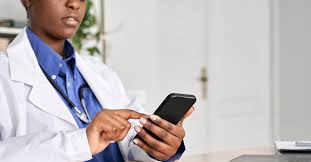Health Monitoring Beyond Beyond Hospital Walls
By Sophia Friesen—Researchers are focused on the power of digital health tools to capture relevant health information in people’s daily lives. Two decades of research have shown that enabling people to self-report symptoms from home can improve quality of life for cancer patients, explained Elizabeth Sloss, PhD, RN, research assistant professor in the University of Utah College of Nursing. She aims to take the next step and integrate symptom reporting systems into routine care. Meanwhile, Selena Cho, graduate student in mechanical engineering in the John and Marcia Price College of Engineering, is developing wearable devices that can detect long-term concussion symptoms.
EMPOWERING PATIENTS
Technology can also increase patients’ agency over their medical care. The Going Home toolkit, an app for patients leaving the hospital, helps people organize their networks to address needs like groceries and transportation, said Jesse Ferraro, project manager in the Therapeutic Games and Apps Lab in the School of Medicine. Jorie Butler, PhD, associate professor of biomedical informatics and research associate professor of geriatrics in the School of Medicine, has designed an app for older pain patients and their doctors that helps prompt shared decision-making and bring patient values into the picture. And a computer game-like tool created by Sarah Shizuko Morimoto, PsyD, associate professor of population health sciences in the School of Medicine, shows promise for helping people with late-life major depression change their own brain activity for the better.
Associate director Tatiana Allen-Webb, CCRP, for the Utah Area Health Education Centers program, cautions that any advancements need to be carefully considered to avoid exacerbating health inequities. “So many of the things we do capture a specific patient population, but sometimes the populations who need them the most are skipped,” she said. For instance, programs that involve a smartphone-based app exclude people who can’t afford or use a smartphone.
But if they’re properly integrated with existing systems of local providers, digital health tools can improve health equity, said Paul Estabrooks, PhD, professor of health and kinesiology in the College of Health. Like many other symposium attendees, Estabrooks took time after the research presentations to talk through new ideas for digital health at collaborative discussion tables. “We can use technology as an extension of the health worker to reduce disparities as well as build trust in communities,” Estabrooks said.
One of the ways to ensure that digital tools work for everyone is to listen and collaborate, said Laura Marquez, senior director of digital transformation at U of U Health. Marquez came to the symposium to brainstorm improvements for patient-facing tools like MyChart. To effectively remove barriers between patients and their health information, researchers must collaborate across many disciplines—which is why the DHI symposium is so important, Marquez said. “Events like these help break down those walls.”
Category: Uncategorized

